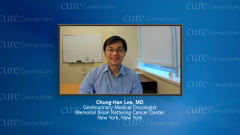
Lenvatinib + Pembrolizumab for the Treatment of Metastatic Clear Cell RCC
A review of clinical trial data on combination treatments for clear cell renal cell carcinoma.
Episodes in this series

Chung-Han Lee, MD: One of the common approaches in addition to doing dual immune checkpoint inhibitors is using a combination of a tyrosine kinase inhibitor [TKI] with an immune checkpoint inhibitor, with at least four different regimens undergoing regulatory approval in the United States. The most recent of which was the combination of lenvatinib [Lenvima] plus pembrolizumab [Keytruda], with pembrolizumab being the immune checkpoint inhibitor and lenvatinib being a tyrosine kinase inhibitor. That’s focused on addressing and attacking the blood vessels that feed the kidney cancer. This was most recently approved based on the CLEAR study, which looked at the safety and efficacy of the regimen in comparison with sunitinib [Sutent], which is the old drug that Mr Lewis mentioned earlier.
The main efficacy end point that they looked at was progression-free survival. It met that efficacy end point and demonstrated a median progression-free survival of 24 months. It also had key secondary end points looking at the objective response rate and overall survival. The regimen demonstrated improvements in objective response rate and overall survival. The combination demonstrated that about 71% of patients had a significant shrinkage to their disease, with about 16% of patients having a complete response. A complete response means that all of the lesions that we can see on scans shrink to a size that we can’t see on imaging studies, which is very impressive. We haven’t seen those types of results before. We need longer-term follow-up of this regimen to try to figure out whether those responses will continue to be durable. The regimen demonstrated improvements in overall survival compared with sunitinib.
The study also did some subgroup analyses looking at the difference based on the risk stratification and demonstrated improvements regardless of risk stratification or whether the kidney was already removed. Basically, it did better in terms of the favorable-risk patients, intermediate-risk patients and poor-risk patients. The study also looked at different sites of disease where the combination performed better than just the disease by itself.
There was some initial preliminary biomarker work that was done for the study based on the original phase 2 study. Based on these studies, there was some biomarker analysis looking to analyze whether there are predictive biomarkers that can drive the outcomes to this. They looked at genomic biomarkers and gene expression biomarkers. Genomic biomarkers are genetic changes that can be associated with response or resistance. Gene expression biomarkers look at the actual expression of certain genes.
Within some of the genomic biomarkers, they identified an association with HLA [human leukocyte antigen] diversity, the ability to present different antigens. That’s inherited. Those data are based on a small number of patients because it’s from the original phase 2 study. We need to validate that within a larger group to see whether this is something that’s truly predictive or an accent due to the small sample size that were analyzed. We’re looking forward to seeing whether that continues to hold true when we analyze the phase 3 study.
The investigators also looked at gene expression biomarkers. There have been multiple studies looking at different gene expression patterns, like whether people with high levels of angiogenesis or high levels of blood vessel formation respond better to tyrosine kinase inhibitors. Some of the studies did show that. And then for the combination of lenvatinib plus pembrolizumab, we’re waiting to see whether that continues to hold true in the phase 3 study.
In thinking about this new regimen that has come out, we have to think about this in the context of all of the various tyrosine kinase inhibitors, or TKI/IO [immuno-oncology], approaches that are available, and also in the context of the availability of ipilimumab [Yervoy] and nivolumab [Opdivo].
Transcript edited for clarity.









